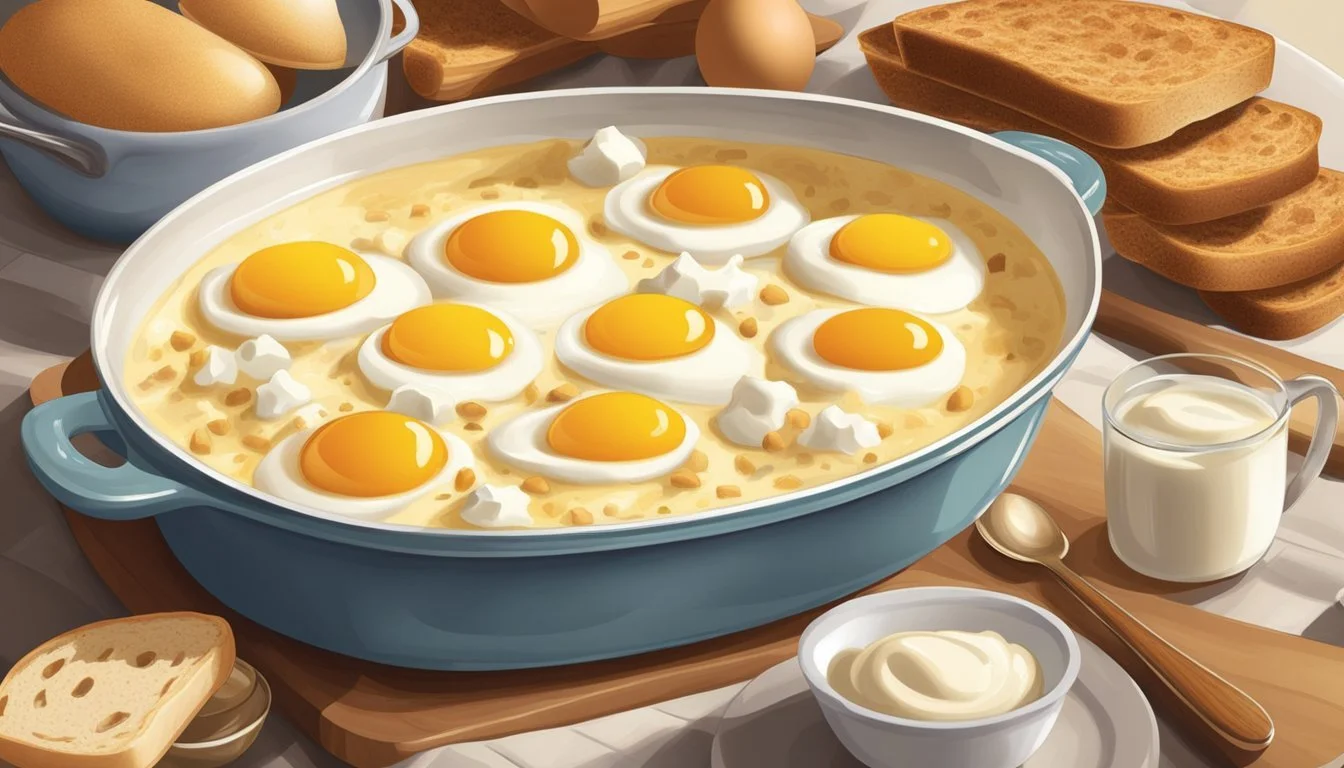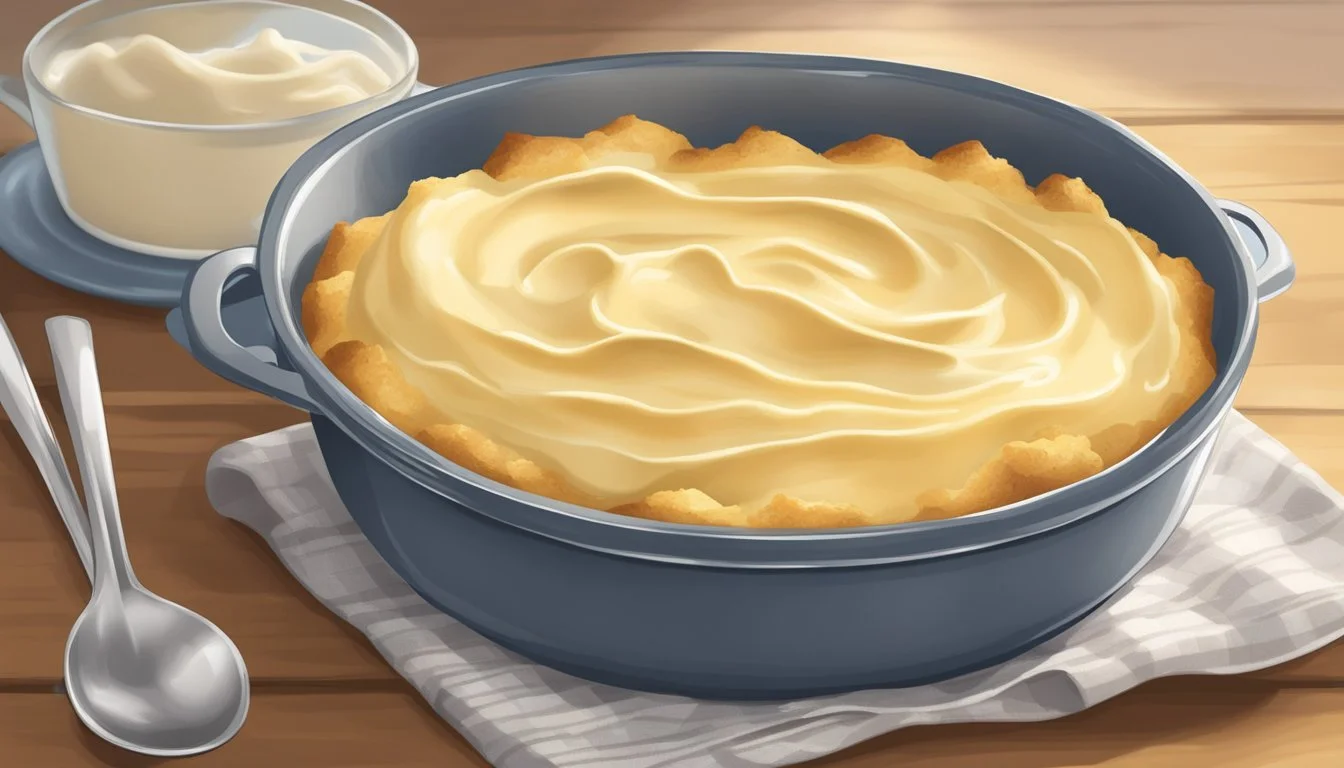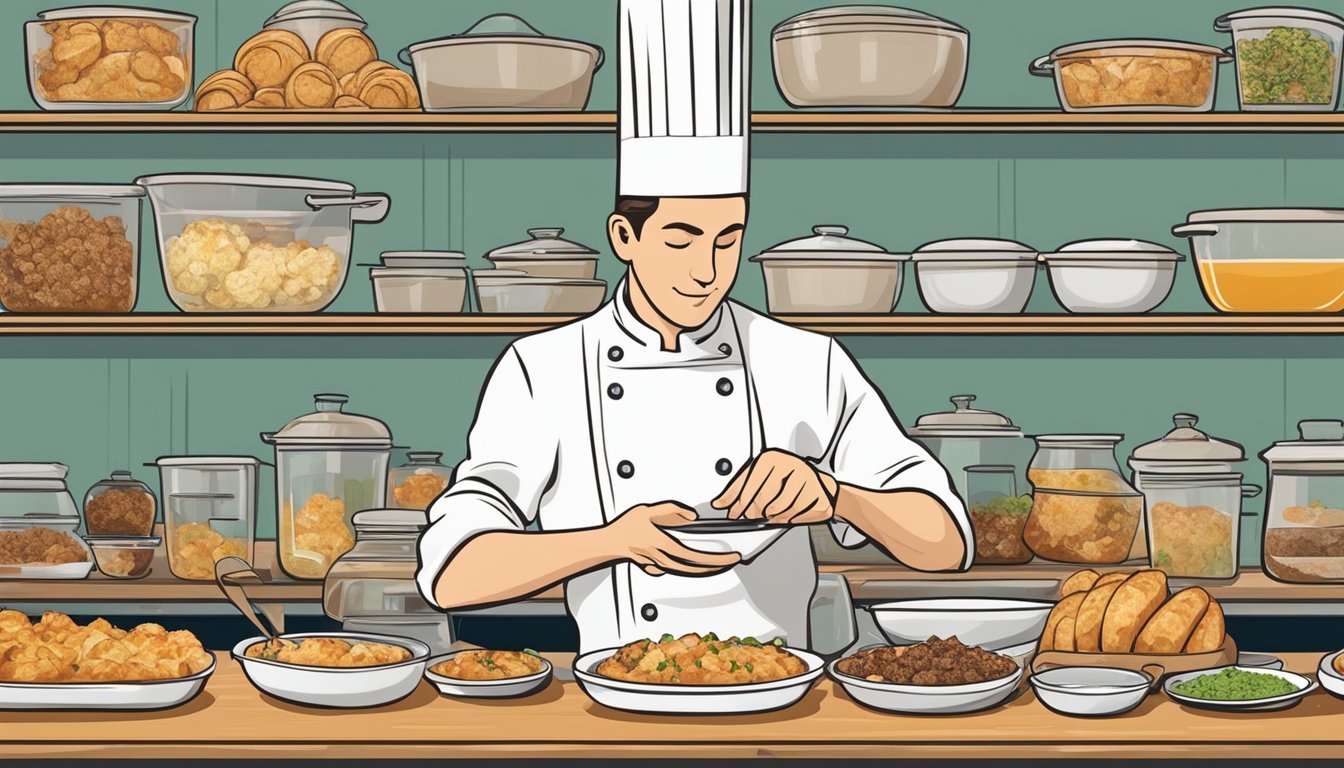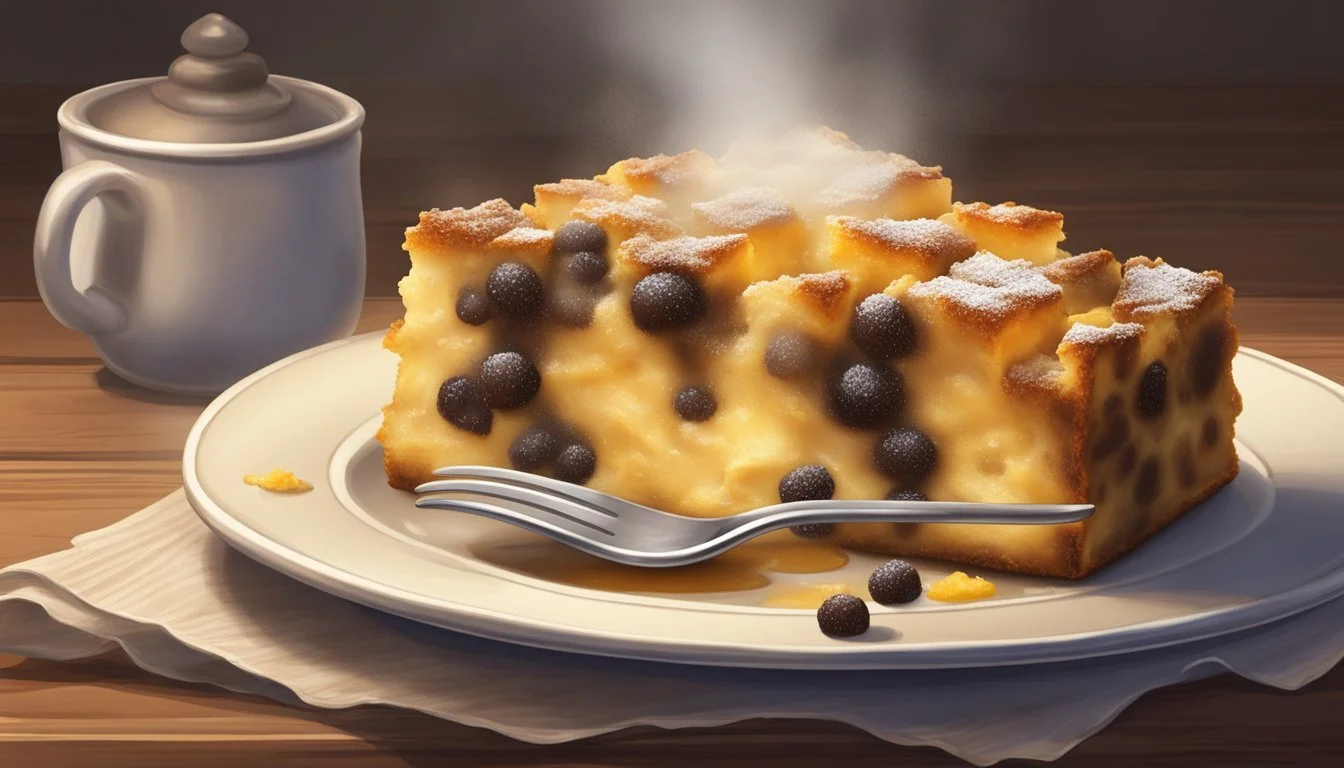Reviving Stale Bread Pudding
Techniques for a Perfectly Moist Dessert Casserole
Stale bread (What wine goes well with bread?) pudding often appears disheartening, sitting there dry and less appetizing than its freshly baked counterpart. Yet, this classic dessert casserole can be revived, transforming it back into a moist and custardy treat. Bread pudding, with its humble beginnings, has stood the test of time as a beloved comfort food. Its ability to deliver a rich and satisfying experience largely depends on its texture and flavor, which can be rescued even after it's lost its initial allure.
Reviving stale bread pudding is akin to rejuvenating the essence of the dessert. The process is not merely about reheating but restoring its characterful moisture and creating a custardy consistency that is both inviting and indulgent. Techniques and ingredients employed in this revival are crucial to achieving the perfect balance, ensuring the bread pudding retains its integrity while coaxing out its inherent richness.
This endeavor reflects the broader trend of minimizing food waste, giving leftovers a second life. Rescuing stale bread pudding not only makes economic sense but is a testament to the resourcefulness embedded in culinary traditions. Bread pudding itself was born from a need to use up bread before it went to waste, and the practice of reviving it continues this legacy. The resulting dish is not just a restored dessert but also a homage to the dish's roots and an exercise in culinary ingenuity.
Understanding Bread Pudding
Bread pudding is revered as a comfort food that transforms stale bread into a sumptuous dessert, utilizing simple ingredients to yield a moist and custardy treat.
Historical Context
Bread pudding has its origins as a frugal dish designed to use up stale bread, preventing waste. Dating back to the early 11th and 12th centuries, it was a practical solution for extending the shelf-life of bread. This old-fashioned dessert quickly became a staple in many cultures due to its simplicity and the ability to easily add local flavors.
Foundational Ingredients
A traditional bread pudding recipe includes staled or dried bread, milk or cream, sugar, and eggs. The bread serves as a sponge, absorbing the mixture of the other ingredients. The eggs and milk coalesce to form a custard that binds the dish, while sugar adds sweetness.
Key Ingredients Purpose Bread Provides structure and soaks up custard Milk/Cream Basis of the custard Sugar Sweetens the pudding Eggs Create custard and add richness
Custard Bread Pudding Vs. Other Desserts
In comparison to other desserts (What wine goes well with desserts?), custard bread pudding stands out for its unique texture and moistness. While cakes and cookies are often denser or crispier, bread pudding offers a moist, soft consistency with a creamy, custard-like middle. The use of stale bread specifically results in a dessert that is hearty yet delicate when baked.
Variations of Bread Pudding
Bread pudding can be adapted to include a wide array of stir-ins like raisins, nuts, berries, and chocolate. It can also be enhanced with various sauces such as caramel, thickened fruit purees, and even zesty additions like lemon juice, offering endless customization. Each variation not only alters the flavor profile but also the texture and density of the pudding.
Add-ins: Raisins, nuts, chocolate
Sauces: Caramel, fruit purees, lemon juice
Consistency: Adjustments can make it lighter or denser
This diverse dessert evolves with each recipe, giving it a cherished place in both humble kitchens and upscale dining venues.
Importance of Ingredient Quality
Crafting a moist and custardy bread pudding hinges on the selection of premium ingredients. Each component plays a pivotal role in the overall texture and flavor of the dessert.
Bread Selection
The foundation of any bread pudding is, as the name implies, bread. Stale bread is ideal; its dryness allows for superior absorption of the custard mixture. For a traditional recipe, French bread tends to be a top choice due to its firm texture, which holds up against the custard. Bread cubes from a day-old loaf ensure your pudding has the right balance of moistness without becoming soggy.
Milk and Cream Choices
The custard base is crucial for a luscious dessert casserole. A blend of whole milk and heavy cream imparts a creamy richness that can't be matched by lower-fat alternatives. Heavy cream contributes to the custardy texture, making it decadent.
Egg Selection and Use
Large eggs bind the ingredients in bread pudding, affording it structure and richness. For the most luxurious custard bread pudding, incorporating eggs properly is vital—they must be whisked thoroughly until frothy before introducing the milk and cream.
Sweeteners and Flavorings
Flavor depth comes from the sweeteners and spices used. Brown sugar offers a molasses note, while granulated sugar adds sweetness without altering the flavor profile. A hint of vanilla extract provides a warm, aromatic base often matched with spices such as cinnamon and ground nutmeg. For a twist, a splash of Grand Marnier can add a subtle orange essence, while toppings like caramel or jam can enhance the dessert's character.
Preparation Techniques
In creating a moist and delectable bread pudding, attention to detail during the preparation phase is crucial. From the initial treatment of the stale bread to the final baking process, each step influences the overall texture and flavor of the dessert.
Reviving Stale Bread
Stale bread forms the backbone of any bread pudding, providing the necessary structure to absorb the custard mixture. If the bread is too fresh, it may become too soggy, while overly dry bread might not soak up enough of the flavorful custard. To revive stale bread, it is often best to cut it into 1.5-inch cubes. For bread that isn’t quite dry enough, a brief toasting in the oven can aid in achieving the perfect dryness.
Preparation:
Cut stale bread into cubes.
If necessary, toast bread cubes lightly in an oven set to 300°F (150°C) for 10-15 minutes.
Creating the Custard Mixture
The custard mixture, a rich and creamy blend of eggs, milk or cream, and sugar, is what truly transforms the dish. With proper whisking, the eggs integrate smoothly, avoiding any separation or curdling in the final product. Aromatic spices like vanilla extract, ground cinnamon, and ground nutmeg can be added to the custard for depth of flavor.
Ingredients:
Whisk together eggs, milk or cream, and sugar until smooth.
Incorporate vanilla extract, cinnamon, and nutmeg as desired.
Layering and Baking
To assemble the bread pudding, it’s recommended to use a buttered casserole or baking dish to prevent sticking and to add a subtle richness to the crust. The bread cubes are then layered evenly within the dish before the custard mixture is poured over the top, allowing the bread to soak up the flavors thoroughly.
Assembly:
Place bread cubes in a greased baking dish.
Pour custard mixture over the bread, ensuring even absorption.
The final step involves baking the bread pudding in a roasting pan filled with water to create a gentle cooking environment, akin to a bain-marie. This method ensures even heat distribution and a custard that sets just right - firm, yet tender. The pudding is baked until it has a golden-brown crust and a slight jiggle in the center.
Baking:
Bake in a water bath at 350°F (175°C) until the top is golden and the center nearly set, typically between 30-45 minutes.
Serving Suggestions
When serving bread pudding, the dessert can be elevated with the right complement of sauces, toppings, and beverages. These additions should enhance, not overwhelm, the delicate flavors of the bread pudding.
Accompanying Sauces
To add a layer of richness to the bread pudding, one can consider drizzling it with a caramel sauce or crafting a custard-like bread pudding sauce. These sauces, when warmed, not only impart a velvety texture but also infuse the dessert with a glossy sheen that is visually appealing.
Caramel Sauce: Warm and pour over the dessert for a sweet, buttery flavor.
Bread Pudding Sauce: Typically a vanilla-based sauce that adds a creamy texture.
Add-ons and Toppings
Bread pudding's versatility allows for an array of toppings that can add texture and flavor diversity. A dollop of whipped cream or a scoop of vanilla ice cream can provide a cool contrast to the warm dessert. Sprinkling powdered sugar lightly on top offers a sweet finish, while adding nuts such as pecans or walnuts introduces a crunch.
Whipped Cream: A light and airy option for a smooth finish.
Nuts: Sprinkle chopped pecans, walnuts, or raisins for added crunch and flavor.
Fruit: Fresh berries or dried fruit can introduce a tart or chewy element to the dish.
Pairing with Beverages
Ideal beverage pairings can cleanse the palate or complement the rich flavors of the dessert. A glass of milk can mirror the creamy elements of the pudding, while coffee or tea can provide a bitter or herbal note that contrasts with the sweetness of the dessert.
Milk: A classic pair for its creamy texture that matches the dessert.
Coffee: Offers a robust flavor that contrasts with the sweet pudding.
Tea: Provides a lighter, aromatic complement to the bread pudding.
Nutritional Information
The nutritional value of bread pudding can vary depending on the ingredients used. This section breaks down the typical caloric content of bread pudding and suggests healthier ingredient alternatives to improve its nutritional profile.
Caloric Content
Traditional bread pudding is a rich dessert that includes bread, sugar, milk, and eggs as its core components. Depending on the size of the serving, a piece of bread pudding can contain anywhere from 200 to 500 calories. The major contributing factors to this caloric range are the sugar and the milk, which provide a substantial amount of the dessert's energy content.
Healthier Ingredient Alternatives
Sugar: To reduce the calorie count, one could substitute white sugar with alternatives like stevia or other low-calorie sweeteners. Reduced-sugar recipes may use only half a cup of sweetener as opposed to the standard one cup.
Milk: Replace full-fat milk with low-fat or almond milk to cut down on calories and fat. One cup of almond milk contains approximately 30 to 50 calories, contrasted with 150 calories for whole milk.
Bread: Opting for whole grain bread instead of white adds fiber and nutrients. Two slices of whole grain bread typically contain around 138 to 220 calories and 3 to 4 grams of dietary fiber.
By considering these ingredient swaps, one can enjoy a more nutritious version of bread pudding without significantly compromising on taste or texture.
Storing and Reusing Leftovers
To maintain the delightful texture and flavor of bread pudding when it's not consumed immediately, proper storage and reheating techniques are critical. Implementing the right methods can transform leftovers into an almost freshly baked experience, whether for a hearty breakfast or a scrumptious brunch (What wine goes well with brunch?) treat.
Optimal Storage Practices
For bread pudding, cooling is a paramount step. Leftovers should cool completely to room temperature, which typically takes about two hours. This prevents condensation from making the bread pudding soggy. Once cool, it should be wrapped tightly or placed in an airtight container to maintain freshness. The refrigerator offers the optimal environment to store leftover custard bread pudding, safeguarding its creamy texture and preventing bacterial growth.
Refrigeration: Store in the fridge for up to 5 days.
Freezing: For extended storage, wrap and freeze.
Reheating for Best Results
Microwave: To retain moisture when reheating, place the bread pudding in a microwave-safe dish and cover it lightly. Heat on 50% power in increments of 60 seconds, checking frequently until thoroughly warmed through. This method helps avoid overheating, which can dry out the custard base.
Oven: For those preferring a crisp top, preheating the oven to 350°F and placing the bread pudding in a baking dish with some water at the bottom can recreate the original baking environment. Cover with foil and heat until warm, approximately 20 minutes.
Air Fryer: For a quicker option, the air fryer can reheat slices at 350°F for about 3-5 minutes.
Transforming Leftovers
Leftover bread pudding can be given a new lease on life beyond its initial serving.
French Toast: Repurposed as French toast, slices can be dipped in an egg mixture and fried until golden brown, offering a twist on a breakfast classic.
Brunch Casserole: Chunks of leftover bread pudding can be used as a base for a custard-rich brunch casserole, adding in ingredients such as fruit, nuts, or chocolate chips to enhance the flavor profile.
By adhering to these storage and reheating suggestions, one can ensure that leftover bread pudding remains a delectable treat.
Frequently Asked Questions
Q: What is the best type of bread to use for bread pudding?
A: Stale bread, such as a French loaf or croissants, is ideal because it absorbs the custard mixture well, contributing to a moist texture.
Q: Can bread pudding be made without dairy?
A: Yes, one can substitute regular milk with plant-based alternatives like almond or soy milk.
Q: Is it necessary to use eggs in bread pudding?
A: Eggs are essential for the custard base, but for those with allergies, egg substitutes or silken tofu can be used with varying results.
Expert Tip For a richer custard, incorporate a combination of whole milk and heavy cream.
Q: How do you know when bread pudding is done baking?
A: Bread pudding is done when the top is golden brown, and the custard is set—this can be tested by inserting a knife in the center; it should come out clean.
Q: Can bread pudding be made in advance?
A: Absolutely! Assemble the elements, refrigerate, and simply bake prior to serving. It's ideal for make-ahead meals.
Q: What can be added to bread pudding for more flavor?
A: Options include vanilla extract, cinnamon, chocolate chips, nuts, or dried fruit for added taste and texture.
Q: How do you prevent bread pudding from becoming dry?
A: Ensure there is enough custard mixture to cover the bread. Briefly soaking the bread before baking helps too.
Q: Can bread pudding be reheated?
A: Yes, it can be gently reheated in the oven or microwave. Covering with foil in the oven prevents it from drying out.
Conclusion
Reviving stale bread pudding can be a gratifying experience for anyone eager to breathe new life into this comforting dessert. Methods like gentle reheating in the oven and ensuring even distribution of moisture with a custard mixture are key to restoring its luscious texture. An oven temperature between 300-350℉ (149-177℃) is ideal, with a typical reheating time of 10-15 minutes possibly adjusted based on the size and density of the bread pudding.
For those who find their bread pudding has dried out, an extra pour of custard mixture before reheating can help. Home chefs should remember to:
Check for doneness with a skewer or toothpick—it should come out clean when the bread pudding is moist but fully cooked.
Let the dish rest for a few minutes after baking for the custard to set properly.
Enjoying a revived bread pudding means one can appreciate a delightful dessert without the waste. Such practices not only enhance culinary experiences but also contribute to sustainable kitchen habits.
In conclusion, reviving stale bread pudding is straightforward when one pays attention to temperature, moisture, and timing. These minor adjustments help ensure that every serving of bread pudding is as enjoyable as the first.







